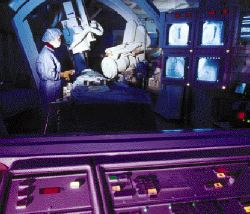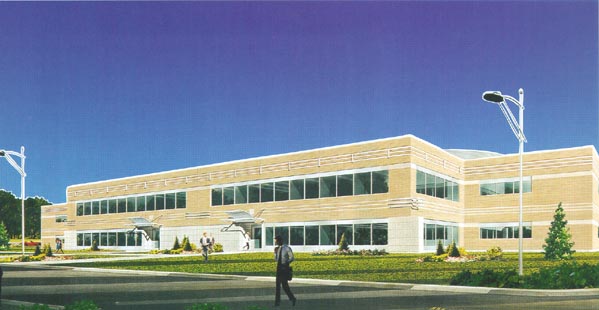Quebec
by Louise A. Legault and David Napier
Activity in aerospace, telecommunications, biotechnology
and many other fields reveal how Quebec has gone high tech at low cost.
The assembly lines in Quebec (pop. 7.3 million) continue to rumble along, churning out an impressive mix of worldclass goods ranging from automobiles to airplane engines to telecommunications equipment. So great is this province's production power, in fact, that exports represent almost 30 percent of its total GDP of US$127.3 billion (1995).
Quebec's immediate future looks promising. Between 1998 and 2004, Quebec's pharmaceutical industry alone will get an investment injection of $1.5 billion, say Quebec government reports.
All the (Tax) Breaks
Research speaks:
For example, consider a 1994 research report on Quebec's foreign investment by government relations consultants Corporate Affairs International (CAI), which was based on a survey of more than 90 multinational companies at work in the province. What the CAI survey found was that Quebec's quality manpower and life, easy U.S. market access, solid infrastructure and government support all weighed heavily in those firms' decisions to invest in the province.
As a result, "Close to 1,200 foreign companies already have a foothold in the Quebec economy," says Marc St-Onge, general manager of Foreign Investment in the province's Ministry of Industry, Commerce, Science and Technology (MICST). "In 1996 alone, Quebec received $2.2 billion in direct international investments," he adds.
 |
 |
| Research at the Centre Hospitaliér de l'Université Laval (CHUL) has resulted in major investments from pharmaceutical companies such as Schering Plough. |
|
Notwithstanding a healthy concentration of companies, Quebec is home to numerous research centers and training establishments that are active in key sectors of the new economy.
The reason behind such a fertile R&D field has much to do with tax breaks. The federal government allows a 20 percent tax credit, while Quebec allows the same percentage to take the form of a refundable tax credit on salaries allocated to in-house R&D.
In the case of small business or when R&D is carried out by a recognized research center, this 20 percent rate doubles to 40 percent. The province further rewards innovation with low taxes on profits and advantageous depreciation rates (certain computer hardware and software can be written off during the year of purchase). Foreign researchers working for Quebec firm are also granted a two-year income tax exemption.
|
All these perks translate into technology-based R&D in Quebec -- technology that's growing at a rate three times faster than anywhere elsewhere in Canada. In fact, more than half of all Canadian university R&D industrial funding is concentrated in Quebec. That research activity is so great, in fact, that, if compared with OECD countries, the province alone would rank 10th in terms of total research expenditures.
In the last five years, Quebec has also positioned itself as one of the country's venture-capital centers. A barrage of new investments is the result of an elaborate financial montage, with some of the key players including the massive, government-run pension fund manager Caisse de dépot et placement du Québec, labor funds, such as the Fonds de Solidarité des Travailleurs du Quebec (FTQ), and venture-capital funds such as Innovatech du Grand Montréal (established in 1992 to give a boost to Montreal's 'new economy').
All told, the more than 60 regional and specialized funds bring the province's total available venture capital to more than $1.5 billion.
Montreal: Activity Hub
Regardless of whether it's business, politics, education or social affairs, one thing is certain in Montreal: The province is always in the thick of things. One of the major reasons: It's a vital hub for domestic and international transportation -- the city is served by three railroad carriers, two international airports and a worldclass port and a web of highway connections.
These days, however, infrastructure and economic activity have become synonymous with information technology. Again, Montreal is up to speed.
The city is home to more than 1,000 high technology companies, boasts the highest density of high-tech jobs per capita (says a 1995 Price Waterhouse survey), and is responsible for 60 percent of all Canadian telecommunications and aircraft exports.
For foreign telecommunications and aircraft concerns, manufacturers such as Bombardier Inc. -- the world's third-largest aerospace manufacturer -- and Spar Aerospace -- which is aligned with the U.S. Space Station project -- have been huge drawing cards. Their presence encourages telecommunications and aircraft firms to set up shop in the province and tap into the North American market, capitalizing on a deep pool of qualified subcontractors.
Montreal's economic strengths are also apparent in the pharmaceutical industry. The city is, in fact, home to more than 40 percent of drug companies in Canada, including Merck Frosst, Bristol-Myers Squibb and Wyeth-Ayerst.
 |
| Quebec's solid reputation in high-tech circles rest on facilities such as Montreal's Multidisciplinary Research Complex of the Technoparc, Campus Saint-Laurént. |
Montreal's Biotechnology Research Institute has also attracted a host of bio-tech companies, including the Netherlands' Bio-Intermediair and U.S. firms MethylGene, Cystar Therapeutics and Seragen Biopharmaceutique.
So what's the secret underlying Quebec's business attractiveness? Aldo Baumgartner, Wyeth-Ayerst Canada president and CEO, sums up many of the province's strengths when he says, "The superior universities and the availability of highly skilled workers, plus excellent tax incentives for research and development make Canada an ideal investment location."
Quebec City:
Research and Resources
In Quebec City (est. pop. 650,000), the pharmaceutical industry's ranks alone have grown from three establishments in 1994 to 17 in 1996.
Similar growth has been realized in other sectors, thanks to resiliency in the face of recent economic pressures. A world-renowned tourism and convention destination, the historic city on
the St. Lawrence River was, in the late 1980s, faced with severe cutbacks. But it has bounced back admirably.
The latest 1995 figures indicate $66 million was invested in 18 major projects in the Quebec City area.
In addition to having one of North America's first academic institutions -- Laval University, founded in 1852 -- and some 100 research centers, the Société de Promotion Économique du Québec Métropolitain has identified eight sectors where Quebec City excels. One key advantage is its deep-water port facilities, open year-round to navigation. Another is the presence of an international airport and efficient rail and road links to all major points in Canada and the United States.
These facilities were foremost in the minds of Degussa A.G. executives when they chose to locate a new $102 million peroxide plant in the region. Richard Owins, Degussa Canada Ltd.'s Peroxygen Chemicals Division vice president and general manager told Canada Investment News that after considering other North America sites, including Degussa's Alabama plant, they settled on Quebec City. "This site offers us several important advantages," he said, specifically citing clean air and proximity to uncontaminated water, as well as access to a year-round deep-water port.
High Praise Indeed
CEOs of countless foreign companies have applauded their Quebec-based employees' efforts.
The praise is well directed. After all, Quebec subsidiaries of multinationals have secured more than 100 research and production mandates from their parent companies. For instance, Ericsson Communications in recent years landed three research mandates on mobile telephony from its Swedish headquarters.
Quebec's trickle-down business has been bolstered by many other factors, say corporate bosses like Daniel Branda, Hewlett-Packard (Canada) Ltd., president and CEO. Echoing Quebec's location attractions, Branda is on record as saying, "Engineering talent costs 35 percent less [in Canada] than in the U.S." In addition, Branda says employee turnover is "far lower than that of the U.S., which results in lower costs and less disruptions in projects."
The Outaouais'
High-Tech Edge
The Outaouais region is another major trump card in Canada's high-tech hand.
 |
| Facilities such as the Parc Scientifique et de Haute Technologie in Laval have given Quebec a solid reputation in high-tech circles. |
|
With 1 million consumers concentrated in the cities of Aylmer, Buckingham, Gatineau, Ilull and Masson-Angers, the Outaouais is Canada's fourth-largest urban community. With a strategic location and a young, well-educated work force (with more than 60 percent bilingual), the region's substantial economic development arsenal has produced one of Quebec's most substantial technology centers.
Information technology like geomatics and computer graphics is the stuff of the region's economic backbone. Forty top-notch R&D centers are concentrated in the region, providing the specialized scientific and technological expertise that's driving today's economy. And the information highway's myriad multimedia technologies are fast taking firm root in the Outaouais' fertile economic development turf.
|
In addition, the region's network of quality educational institutions guarantees businesses with local operations an ongoing supply of brainpower, the critical resource driving today's technologically charged growth gazelles. The Outaouais' region's world-renown French, English and Spanish language universities also promote the multicultural skills integral in today's global business milieu.

Wired for Business
Canada's Competitive Cost Advantage
Atlantic Canada
Quebec
Ontario
The West

A Site Selection Special Feature



